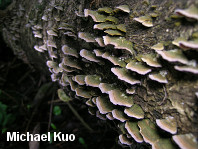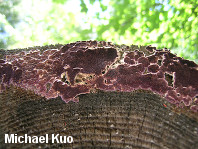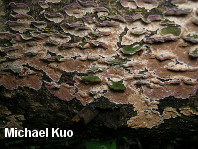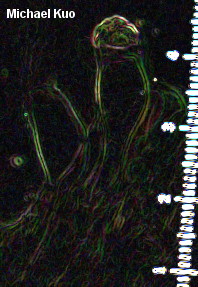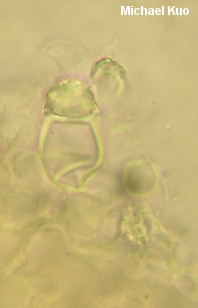| Major Groups > Polypores > Trichaptum abietinum |

|
Trichaptum abietinum [ Basidiomycota > Polyporales > Polyporaceae > Trichaptum . . . ] by Michael Kuo The gorgeous, purple-when-fresh pore surface and the habitat on wood of conifers make Trichaptum abietinum fairly easy to identify. Its closest look-alike is Trichaptum biforme, which does look nearly identical—but which inhabits the wood of hardwoods and is thus easily separated. Trichaptum fuscoviolaceum grows on the wood of conifers, but its undersurface is more toothed (or even gill-like) than poroid. Within the boreal range of tamarack, Trichaptum laricinum is also similar, inhabiting the deadwood of tamarack; its undersurface is slot-like or gill-like. All of these species are virtually inseparable microscopically. Mating studies (Macrae 1967) and early molecular studies (Ko et al. 1997; Kauserud & Schumacher 2003a, 2003b) have more or less upheld the species set forth above, but Trichaptum abietinum has shown fairly significant genetic variation; more than one species may be involved. "Trichaptum abietinus" is an error in Latin perpetuated by several field guides. Hirschioporus abietinus is a synonym. Description: Ecology: Saprobic on the dead or dying sapwood of conifers, especially firs; growing in overlapping clusters on logs and stumps; spring through fall; widely distributed in North America. The illustrated and described collections are from Colorado. Cap: Sometimes absent, or present as merely a folded-over edge, but usually present and semicircular to fan-shaped; 1–4 cm wide; up to 3 cm deep; thin; dry; fuzzy to hairy; with concentric zones of texture and color; shades of gray, with a purplish marginal zone when fresh; often hosting algae and becoming green. Pore Surface: Purple when fresh, especially near the margin; fading to lilac or brownish with age; with 2–3 angular pores per mm; often tooth-like with age or in capless areas; not bruising. Stem: Absent. Flesh: Whitish; tough and leathery. Chemical Reactions: KOH negative on flesh. Spore Print: Not verified by me; reported as white. Microscopic Features: Spores 6–8 x 2–3 µm; smooth; cylindric to slightly allantoid; hyaline in KOH; inamyloid. Cystidia abundant; 20–30 x 5–10 µm; clavate to obutriform; smooth overall but developing distinctive crystalized apices; walls 0.5 µm thick; hyaline in KOH. Hyphal system dimitic; skeletal hyphae 4-9 µ wide, thick-walled, unclamped; generative hyphae 2.5–5 µm wide, thin-walled, clamped. REFERENCES: (J. J. Dickson, 1793) Ryvarden, 1972. (Fries, 1821; Saccardo, 1888; Overholts, 1953; Macrae, 1967; Arora, 1986; Breitenbach & Kränzlin, 1986; Gilbertson & Ryvarden, 1987; Ko et al., 1997; Barron, 1999; Kauserud & Schumacher, 2003a; Kauserud & Schumacher, 2003b; McNeil, 2006; Grand et al., 2008; Desjardin, Wood & Stevens, 2015.) Herb. Kuo 08041002. This site contains no information about the edibility or toxicity of mushrooms. |
© MushroomExpert.Com |
|
Cite this page as: Kuo, M. (2016, June). Trichaptum abietinum. Retrieved from the MushroomExpert.Com Web site: http://www.mushroomexpert.com/trichaptum_abietinum.html |
